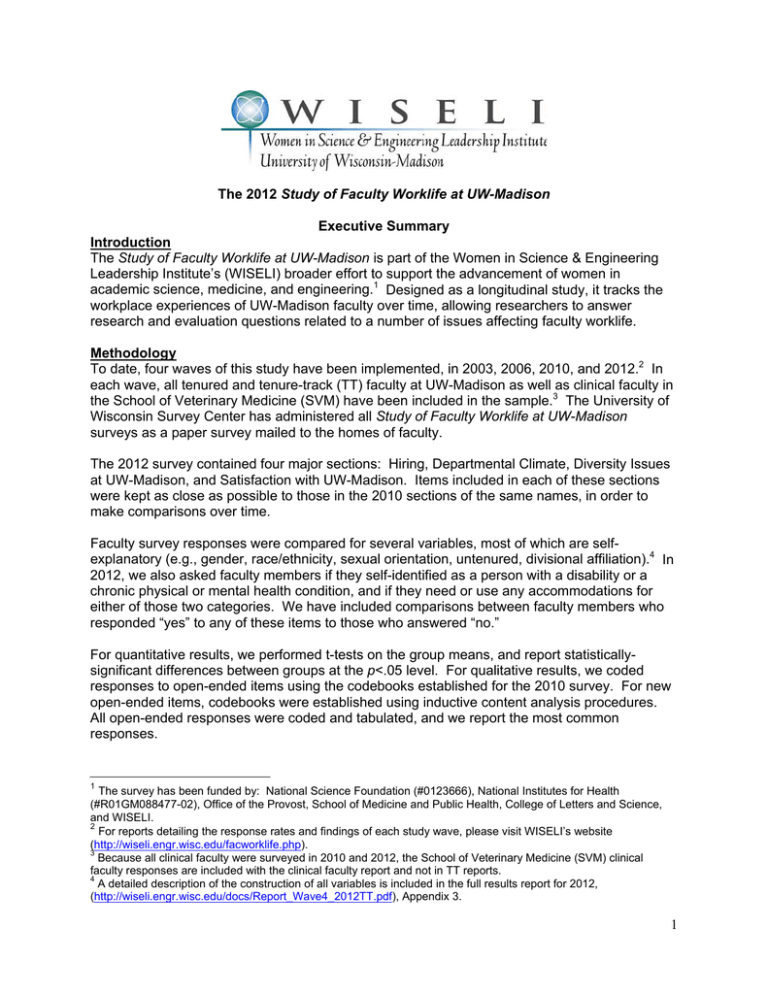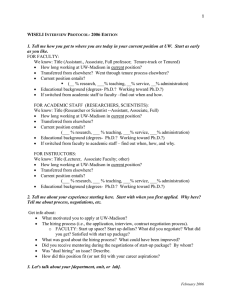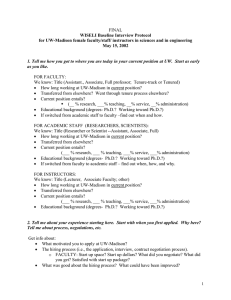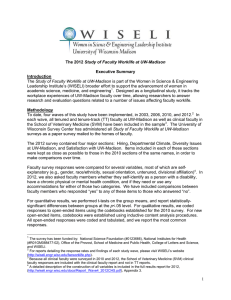Study of Faculty Worklife at UW-Madison Executive Summary
advertisement

The 2012 Study of Faculty Worklife at UW-Madison Executive Summary Introduction The Study of Faculty Worklife at UW-Madison is part of the Women in Science & Engineering Leadership Institute’s (WISELI) broader effort to support the advancement of women in academic science, medicine, and engineering.1 Designed as a longitudinal study, it tracks the workplace experiences of UW-Madison faculty over time, allowing researchers to answer research and evaluation questions related to a number of issues affecting faculty worklife. Methodology To date, four waves of this study have been implemented, in 2003, 2006, 2010, and 2012.2 In each wave, all tenured and tenure-track (TT) faculty at UW-Madison as well as clinical faculty in the School of Veterinary Medicine (SVM) have been included in the sample.3 The University of Wisconsin Survey Center has administered all Study of Faculty Worklife at UW-Madison surveys as a paper survey mailed to the homes of faculty. The 2012 survey contained four major sections: Hiring, Departmental Climate, Diversity Issues at UW-Madison, and Satisfaction with UW-Madison. Items included in each of these sections were kept as close as possible to those in the 2010 sections of the same names, in order to make comparisons over time. Faculty survey responses were compared for several variables, most of which are selfexplanatory (e.g., gender, race/ethnicity, sexual orientation, untenured, divisional affiliation).4 In 2012, we also asked faculty members if they self-identified as a person with a disability or a chronic physical or mental health condition, and if they need or use any accommodations for either of those two categories. We have included comparisons between faculty members who responded “yes” to any of these items to those who answered “no.” For quantitative results, we performed t-tests on the group means, and report statisticallysignificant differences between groups at the p<.05 level. For qualitative results, we coded responses to open-ended items using the codebooks established for the 2010 survey. For new open-ended items, codebooks were established using inductive content analysis procedures. All open-ended responses were coded and tabulated, and we report the most common responses. 1 The survey has been funded by: National Science Foundation (#0123666), National Institutes for Health (#R01GM088477-02), Office of the Provost, School of Medicine and Public Health, College of Letters and Science, and WISELI. 2 For reports detailing the response rates and findings of each study wave, please visit WISELI’s website (http://wiseli.engr.wisc.edu/facworklife.php). 3 Because all clinical faculty were surveyed in 2010 and 2012, the School of Veterinary Medicine (SVM) clinical faculty responses are included with the clinical faculty report and not in TT reports. 4 A detailed description of the construction of all variables is included in the full results report for 2012, (http://wiseli.engr.wisc.edu/docs/Report_Wave4_2012TT.pdf), Appendix 3. 1 Results During Spring of 2012, 2,099 UW-Madison TT faculty received 2012 wave survey instruments. Of those, 1,044 responded, for a 50% response rate. Differential Response by Demographic Characteristics The 50% response rate to the 2012 Worklife survey suggests that a large segment of TT faculty at UW-Madison are represented in survey responses, though response rates varied somewhat across different groups. Women faculty were more likely than Men faculty to respond to the survey (57% vs. 46%). Women Faculty of Color tended to respond at slightly lower rates than Majority Women faculty (50% vs. 59%), while Men Faculty of Color responded at the same rate as Majority Men (46% each). Faculty who are US Citizens responded at higher rates than Non-Citizens (51% vs. 41%). Social Studies faculty had the highest response rate (52%) and Physical Sciences faculty had the lowest (48%). Across schools and colleges, School of Human Ecology faculty had the highest response (62%), while faculty members from the Business School were least likely to respond (39%). Tenured and untenured faculty had similar response rates, although assistant and full professors were slightly more likely to respond compared to associate professors. Hiring Questions in this section examined TT faculty members’ perceptions of UW-Madison during the hiring process, and aspects of the hiring process that may be experienced positively or negatively. Only the responses of faculty members hired after January 1, 2010 were analyzed for this section. New TT faculty members were generally very satisfied with their overall hiring experiences (4.08) and each of the hiring elements about which we inquired. The lowest level of satisfaction for the whole group came with their startup package (3.95), and they were most pleased with their interactions with search committees (4.25). In the hiring section, the most consistent change from 2010 to 2012 was an increase in satisfaction with the resources provided to new hires—both general resources, and startup packages in particular. For all TT respondents, faculty members were more satisfied with their department’s efforts to obtain resources for them (3.90 versus 4.12), and with their start up packages (3.69 versus 3.95). This increased satisfaction with resources was seen for every subgroup analyzed, often significantly so. Climate5 In this section, we asked faculty to assess their interactions with colleagues and others in their departments; to provide their levels of satisfaction with those interactions; to assess the extent to which they participate in departmental decision-making; and to gauge the overall climate, the climate for women, and the climate for faculty of color, all at the departmental level. The TT faculty as a whole reported a fairly positive personal experience of climate. For example, they were often treated with respect by their departmental colleagues, students, staff, 5 Climate is defined by the Campus Climate Network Group (2002) as, “Behaviors within a workplace or learning environment, ranging from subtle to cumulative to dramatic, than can influence whether an individual feels personally safe, listened to, valued, and treated fairly and with respect.” 2 and chairs. They also felt they were solicited for their opinions on work-related matters, and that their research and scholarship were usually valued by their colleagues. When rating the climate experience for others, the faculty believed that the climate in their departments is generally positive. They perceived the climate for women to be positive, and gave slightly lower (but still positive) ratings of the climate for faculty of color. Our results show that the climate experience for some faculty groups was more negative than for others in 2012. The responses for Women faculty, Faculty of Color, Faculty with Disabilities, Arts & Humanities, Untenured, and Non-Chair faculty were consistently lower than that of their comparison groups. Women faculty were less satisfied with climate on virtually all measures for the 2012 survey, as were Faculty with Disabilities. Additionally, Faculty of Color were less satisfied in several areas, including being treated with less respect by colleagues and chairs, feeling excluded from an informal departmental network, and feeling isolated both in their departments and on the UW-Madison campus. Faculty of Color also reported feeling that they had to work much harder to be perceived as legitimate scholars. Among divisions, Arts & Humanities faculty were the least satisfied with their climate experience, while Social Studies faculty were the most satisfied. These findings are largely consistent with previously reported experiences of climate by Women faculty, Faculty of Color, and Non-Chairs in Waves 1, 2, and 3 of the study.6 We observed both positive and negative changes in climate between 2010 and 2012. All TT faculty reported an increase in their colleagues’ solicitation of their opinions about workrelated matters, felt their colleagues valued their research and scholarship more, and all meeting participants were more able to share their views. The total TT group was also more satisfied with their chairs’ efforts to obtain resources for them. Finally, all TT faculty members were more comfortable in raising personal responsibilities with regard to scheduling in 2012. These changes are shown in Figure 1. 6 Because we did not ask faculty members about their identification as a person with a disability prior to Wave 4, comparisons over time are not available on this variable. 3 We also observed some climate changes between 2010 and 2012 for Faculty of Color and Gay and Lesbian faculty, relative to their comparison groups. For these groups, changes in significance on items between 2010 and 2012 often meant worse climate in 2012. For example, there was no significant difference in “respect of colleagues” between Faculty of Color and Majority faculty in 2010, but in 2012 Faculty of Color felt significantly less-respected by colleagues than their Majority peers. Differences for these items are seen in Figure 2. Similarly, Gay and Lesbian faculty fit less-well in their departments in 2010 than Hetero/Bisexual faculty, and rated their overall department climate as less positive, but not significantly so. By 2012, Gay and Lesbian faculty were significantly less likely to say they “fit” compared to their peers, and gave a significantly less positive rating of their department climate. Thus, the direction of the differences was consistent, but the differences became more marked over time. Diversity7 In this section we asked the faculty about the commitment to diversity demonstrated in their departments and on the campus, and about their personal commitment to increasing diversity at UW-Madison, including actions they may have taken toward that end. We also asked about their awareness of unconscious or implicit bias, and whether they had experienced or observed a situation in which bias may have played a role. Overall, TT respondents agreed slightly that commitment to diversity is demonstrated at the departmental and campus levels, and they somewhat agreed that they were personally committed to increasing diversity at UW-Madison. Women faculty, Faculty of Color, Faculty with Disabilities, Gay and Lesbian faculty, and Non-Chairs were less likely than members of their comparison groups to agree that commitment to diversity was demonstrated in their departments or on the campus. These groups were also usually more personally committed to increasing diversity and were more likely to report they had taken an action to increase diversity on the campus, with the exception of Non-Chairs. The most commonly reported types of actions to increase diversity included the recruitment, admission, hiring, and teaching of students; the recruitment and hiring of other faculty and staff; and service and leadership activities. 7 In the survey instrument, diversity was defined broadly as “race, ethnicity, gender, ability/disability, sexual orientation, or other personal characteristics that made us different from one another.” 4 An overwhelming majority (87%) of TT faculty agreed that they were familiar with the concept of implicit or unconscious bias, while approximately one-third (35%) said they had personally experienced or witnessed an incident in which bias could be at play. The situations identified in these incidents included disrespectful or inequitable treatment in interpersonal interactions, exclusion from critical decision-making processes, and hiring situations. Between waves, the proportion of faculty who intentionally engaged in an action to increase diversity in the six months before the survey decreased significantly for most groups. However, this is almost certainly attributable to a change in measurement technique, the implications of which are discussed in the full report. We also observed that personal commitment to increasing diversity among faculty, students, and staff at UW-Madison increased significantly for all TT respondents (from 6.14 to 6.25). This increase was also significant for faculty who are Men, Citizens, from the Biological Science and Arts & Humanities divisions, in Science departments, Tenured, with a Single Appointment, and Non-Chairs. Satisfaction Questions in this section asked the faculty about their satisfaction with their employment at UWMadison and to share what factors both contribute to and detract from their satisfaction the most. We also asked about the likelihood that they would leave UW-Madison in the next three years, and the extent to which they had considered reasons for leaving the institution. Consistent with results from previous waves in the Study, we found that Women faculty, Faculty of Color, and Gay and Lesbian faculty were less satisfied with their jobs as faculty members and with their career progression at UW-Madison. In 2012, Faculty with Disabilities reported being less satisfied with their positions and career progress. For Faculty of Color, these differences in satisfaction were present in 2010, but became significant in 2012. The differences in means for responses to the job satisfaction item are shown in Figure 3. Similarly, while Women faculty were less satisfied with their salaries and with the resources available to support their research and scholarship in 2010, these differences became significant in 2012. We also found that all TT faculty respondents and most subgroups were more likely consider leaving UW-Madison in next 3 years in 2012 than they had been in 2010. A description of the results for all groups, including changes observed between waves, is included in the full report. The factors that contributed most to faculty satisfaction did not change between waves, and again included the quality of and relationships with faculty colleagues, the quality of and working 5 relationships with students, and a positive and collegial institutional community. However, factors that detracted from faculty satisfaction changed in 2012. One of the top areas of dissatisfaction in 2010 was related to research support (such as grant administration or IRB); this was barely a factor in 2012. Rather, a new factor related to the turmoil in Wisconsin state politics that occurred in 2011 became a top write-in for dissatisfaction with one’s job at UWMadison in 2012. The other two primary factors for this item included low salaries and frustration with policies and procedures described as bureaucracy. Descriptions, examples, and complete codebooks for these items are included in the full report. Conclusions and Future Research Overall, findings from the 2012 Study of Faculty Worklife largely replicate findings from previous faculty climate surveys at UW-Madison. The climate gaps between Women faculty and Men faculty, Faculty of Color and Majority faculty, and Chairs and Non-Chairs persisted, while gaps between Faculty with Disabilities and Faculty without Disabilities were newly measured and observed. Importantly, while climate for the entire respondent group improved in some areas, several subgroups experienced significant negative changes in climate and satisfaction. Meanwhile, the overall commitment on the part of TT faculty to increase diversity among the faculty, staff, and students on the campus increased. The 2010 and 2012 survey instruments contain very few items that are exactly identical to items in the 2003 and 2006 survey, and therefore we cannot directly compare our current results to those from 2003 or 2006. More sophisticated analyses are taking place to investigate these longer term changes. The Study of Faculty Worklife is an extraordinary longitudinal data source, helping us answer many questions about faculty perceptions of their workplace, and providing correlations between these perceptions and important career outcomes such as productivity, attrition, and satisfaction. Our ongoing analyses will contribute to our greater understanding of our faculty members’ experiences on our campus. 6


